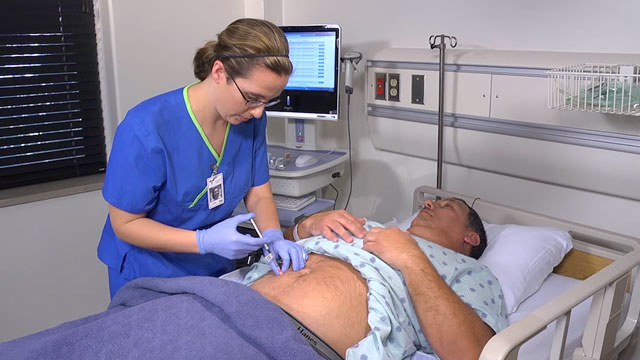Injections
Select a Skill:
- » Preparing Injections from an Ampule
- » Preparing Injections from a Vial
- » Preparing and Administering Insulin
- » Drawing up More Than One Type of Insulin
- » Administering Intradermal Injections
- » Administering Subcutaneous Injections
- » Administering Intramuscular Injections
Take the Review Test:

Safety
- Ensure that the Six Rights of Medication Administration are observed: right medication, right dose, right patient, right route, right time, and right documentation.
- Do not administer volumes greater than 2 mL at a single injection site. For infants and children, the volume injected should not exceed 0.5 mL.
- Wear gloves to reduce the risk of contact with bloodborne pathogens.
- Follow the principles of sterile technique when administering a subcutaneous injection.
- In older adult patients with less elastic skin and reduced subcutaneous skinfold thickness, select the upper abdominal site.
Equipment
(Roll cursor over items to see labels)

U-100 syringe (0.5 to 1 mL) with 28- to 31-gauge needle (optional)
Tuberculin syringe (optional)
Small gauze pad
Alcohol swab
Vial or ampule of medication
Clean gloves
Marker
Tape (to label syring, if necessary)
Delegation
The skill of administering a subcutaneous injection cannot be delegated to nursing assistive personnel (NAP). Before delegating related skills, be sure to inform NAP of the following:
- Outline potential medication side effects, and instruct NAP when to report them.
Preparation
- Check the accuracy and completeness of each medication administration record (MAR) or computer printout against the prescriber’s written medication orders. Confirm the patient’s name and the medication name, dosage, route of administration, and time of administration. Clarify incomplete or unclear orders with the health care provider.
- Note if the patient has allergies.
- Observe the patient’s previous verbal and nonverbal responses to the injection.
- Assess for contraindications to subcutaneous injections, such as reduced peripheral circulation to the injection site area.
- Review the MAR to note the locations of previous injections.
- Assess the adequacy of the patient’s adipose tissue.
- When drawing up medication for injection away from the patient bedside, be sure to label the syringe with the name and amount of medication it contains.
Follow-up
- Return to the patient’s room in 15 to 30 minutes, and ask if he or she feels any acute pain, burning, numbness, or tingling at the injection site.
- Inspect the site, noting any areas of bruising or induration.
- Observe the patient for a therapeutic response to the medication as well as for any adverse effects.
- Confirm the patient’s understanding of the medication’s purpose, action, possible side effects, and self-administration technique if applicable.
Documentation
- Document the medication administered by subcutaneous injection, its concentration, its dosage or strength, the time of administration, and the site of administration. This documentation must be made on the MAR immediately after administration, not before.
- Document any patient teaching and validation of the patient’s understanding.
- Document and report to the health care provider any withheld doses and/or the patient’s response to the medication, including any side effects.
Review Questions
1. Which action would the nurse take to diminish tissue irritation when administering a subcutaneous injection to a patient of average size?
 Massage the site after administration.
Massage the site after administration. Make sure the volume of the medication is less than 2 mL.
Make sure the volume of the medication is less than 2 mL. Administer the injection at a 45- to 90-degree angle.
Administer the injection at a 45- to 90-degree angle. Wear clean gloves while administering the injection.
Wear clean gloves while administering the injection.
2. Which needle would be most appropriate for the nurse to use when giving a subcutaneous injection to a patient of average height and weight?
3. What can the nurse do to minimize the discomfort of a subcutaneous injection?
 Inject the medication rapidly.
Inject the medication rapidly. Massage the injection site.
Massage the injection site. Cover the injection site with gauze pad after withdrawing the needle.
Cover the injection site with gauze pad after withdrawing the needle. Inject the medication without pinching the skin.
Inject the medication without pinching the skin.
4. When preparing to administer heparin or insulin subcutaneously, which site is preferred?
5. What can the nurse do to ensure proper site selection for subcutaneous insulin injection?
 Insert the needle at a 30-degree angle.
Insert the needle at a 30-degree angle. Select a different anatomical region for each injection.
Select a different anatomical region for each injection. Ask the patient to relax before inserting the needle.
Ask the patient to relax before inserting the needle. Systematically rotate sites within the same anatomical location or area.
Systematically rotate sites within the same anatomical location or area.
You have completed the Review Questions for this skill. To take the Review again select the Start Over button. To proceed to another skill select from the dropdown menu. Select the Home or Back button to proceed to the next section.


